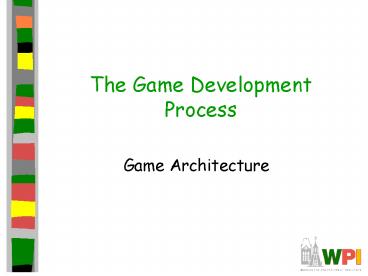The Game Development Process - PowerPoint PPT Presentation
Title:
The Game Development Process
Description:
Consider: Pong, Frogger, Pac-Man, Missle Command, Zelda, Virtua Fighter, Warcraft, Doom ... (Errata .. 17.18 is same as Pacman FSM) ... – PowerPoint PPT presentation
Number of Views:63
Avg rating:3.0/5.0
Title: The Game Development Process
1
The Game Development Process
- Game Architecture
2
Outline
- Tokens
- Initial Architecture
- Development
- Nearing Release
- Postmortem
3
Game Decomposition
- Consider Pong, Frogger, Pac-Man, Missle Command,
Zelda, Virtua Fighter, Warcraft, Doom - What do they have in common?
- All have a player (else a movie or screen saver)
- All have discrete elements that can be directly
or indirectly manipulated - Call these tokens
- Note, tokens objects. Use tokens, tho,
since not always 1-to-1 mapping to software
objects
Based on Chapter 17 of Game Architecture and
Design, by Rollings and Morris
4
Tokenizing Pong
- Bats, Score, Ball, Walls
- Player moves Bat, changes score so sub-tokens
- Goals, too. Defined by area.
- All games can be tokenized (Pac-Man and Balls! in
Rollings and Morris book)
Player
(Game World has rest)
Ball
Goals
Bat
Score
Walls
Based on Chapter 17 of Game Architecture and
Design, by Rollings and Morris
5
Interactions of Tokens (1 of 2)
- Collisions are common
- Token gets message telling collision occurred
- More interactions than collisions. Try
token-token matrix (lower triangle, p. 484) - If impossible, X
- If symmetric, square
- If asymmetric, triangles
- Events Ball-Bat deflection, Wall-Bat stop,
Wall-Ball deflection, Goal-Ball goal event,
Goal?Score goal event. Note, Score?Goal is X - Allows visual check for interactions.
- See errors, missing interactions
- Maybe unexpected chain reactions (could enhance
game, could be unplayable)
Based on Chapter 17 of Game Architecture and
Design, by Rollings and Morris
6
Interactions of Tokens (2 of 2)
- Game World is token. Included in matrix. Needs
to be informed of some events. Act as
intermediary. - Also, objects dont need to know all they may
encounter. Makes it easier to update. - Ex Ball hits goal ? goal generates goal event to
Game world ? game world generates score event
sends to score ? score increments total points - Could later add team score or high score object
and goal would not need to know
Based on Chapter 17 of Game Architecture and
Design, by Rollings and Morris
7
Limitation of Token Matrix
- Can get complicated. Consider Pac-Man (Figure
17.15 in Morris and Rollings) - Tokens have one or more states
- Ghosts hunting, hunted, eaten
- Some interactions more complicated
- Pac-Man eats power pill ? power pill event
- Power pill event ? ghost goes to hunted, timer
reset - Hunted ghost eaten ? eaten event to home base,
calculates how many ? score (200, 400) ? score
to ghost to display
Based on Chapter 17 of Game Architecture and
Design, by Rollings and Morris
8
State Machine for Ghost Token
- Token Matrix gives you big picture
- Finite State Machine (FSM) gives you focus on
specific area (Example of ghost in Figure 17.16) - Single token and how rest of world interacts. Ex
ghost - Hunter (pill) ? Hunted
- Hunted (timer) ? Hunter
- Hunted (pill) ? Hunted (reset timer)
- Hunted (pacman) ? Eaten
- Eaten (resurrect) ? Hunter
- Eaten would trigger score event. That would
appear in FSM of score token
Based on Chapter 17 of Game Architecture and
Design, by Rollings and Morris
9
State Machine for Pac Man
- Hunted (power pill) ? Hunter
- Hunter (timer) ? Hunted
- Hunter (power pill) ? Hunter (reset)
- Hunted (ghost collision) ? Dying
- Dying (if lives gt 0) ? Reset Level event else
Game Over event - This is an open FSM, meaning can be a dead-end
Based on Chapter 17 of Game Architecture and
Design, by Rollings and Morris
10
State Machine for Game World
- Shows how FSM translates to non game aspects
- Pretty generic for all games
- Would be others, such as score, etc.
- FSMs hierarchical, break down finer
- Once mastered, allow visualization of complex game
(Errata .. 17.18 is same as Pacman FSM)
Based on Chapter 17 of Game Architecture and
Design, by Rollings and Morris
11
Initial Architecture Design
- Rollings and Morris, Chapter 20
12
Development
- Rollings and Morris, Chapter 21
13
Run Up to Release
- Rollings and Morris, Chapter 22
14
Postmortem
- Rollings and Morris, Chapter 23































